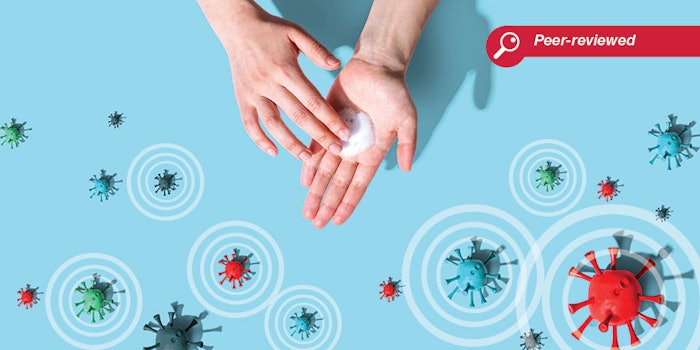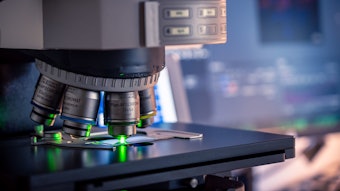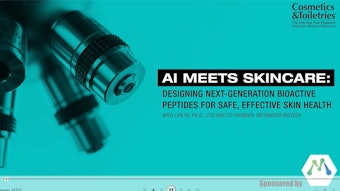
Read this article in its entirety in the September 2020 digital edition. . .
Editor’s note: This first part in our series on hand hygiene provides a brief history of its evolution, considers the nature of viruses, explores hand hygiene protocols and describes the formulation of hand sanitizer gels and foams. Future parts will cover the efficacy of hand sanitizers, regulatory aspects, IP and litigation, and more. Follow along in our upcoming October issue. (See Part II and Part III).
The coronavirus pandemic has placed highly focused attention on the need for hand hygiene. Pleas for regular hand-washing are repeatedly emphasized by health authorities including the World Health Organization (WHO), the Centers for Disease Control (CDC) and the National Institutes of Health (NIH). And, although they are regulated as drugs, hand hygiene products fall clearly within the domain of cosmetics, toiletries and personal care products. Therefore, it is important for cosmetic scientists to understand the science, technology, regulatory and legal aspects of this subject as they pertain to public health.
Providing information about hand hygiene to the public to prevent the spread of disease has had a positive impact, as demonstrated by the correlation between the number of Google searches for “washing hands” and a decrease in the spread of COVID-19 in 21 countries.1 If done properly, hand hygiene is the simplest effective approach to prevent cross-infection and reduce the transmission of infectious agents by contact and fecal-oral routes.2
It is now known that hand hygiene is an important factor in restricting the spread of disease. However, historically, despite evidence of the beneficial effects of cleanliness, the need for hand hygiene was not acknowledged properly for more than a century—even when the consequences of not following the hand hygiene guidelines of health authorities were dire.
Prior to the COVID-19 pandemic, each year, 135,000 deaths in Europe and 99,000 deaths in the United States had been reported from health care-associated infections. In the U.S., more than three-quarters of a million people die of sepsis each year. These numbers are likely under-reported, and they do not account for the number of deaths from infections outside of health care institutions. A leading cause of these deaths is the lack of hand hygiene.3
The Early Struggle for Hand Hygiene4
Antoine Labarraque was a French pharmacist who in 1822, published that the chloride of lime used to deodorize bedpans and corpses also had disinfectant properties.5 James Scott, a British surgeon, learned of Labarraque’s publication and translated it into English, offering the English version as a book for one shilling and a sixpence. By this means, he informed the British medical profession of the disinfectant properties of the chloride of soda.
Chloride of soda was not just sodium chloride, it was in fact hypochlorite bleach—which is still used today to disinfect inanimate objects and water. The ingredients of Labarraque’s solution, which was widely used, were 4% sodium hypochlorite in water and 1% sodium hydroxide or sodium carbonate as a stabilizer, which yielded a pale green, chlorine-smelling liquid that has now been replaced by bleaching powder and household bleach.6, 7
Oliver Wendell Holmes Sr., the father of the famous U.S. Supreme Court Justice, was an American physician who trained in medical schools in Paris and eventually became dean of Harvard Medical School. He visited England and met James Scott, taking Labarraque’s ideas back to America where he postulated that lethal puerperal (childbed) fever was spread by the hands of health care workers. Unfortunately, obstetricians largely ignored his recommendations and deaths from childbed fever continued to be a significant fact of life in the United States.8
In relation, Ignaz Semmelweis was an assistant to a professor at two Viennese maternity clinics. The first clinic had a high incidence of childbed fever and the second had a much lower rate of death for the disease. The first clinic was a teaching clinic while the second one was for midwives only.
Semmelweiss observed that the incidence of childbed fever was much lower for women who gave birth in the street and therefore concluded that something in the clinic was the infective agent. He also noticed that students and doctors who returned from the mortuary had an odor on their hands. Semmelweiss postulated that “cadaverous particles” on the hands were the cause of puerperal fever. This was forty years before Pasteur’s hypothesis of germs.
Semmelweiss instructed students and medical staff to clean their hands with chloride of lime before entering the maternity unit, which dramatically lowered the incidence of childbed fever. Semmelweis published these results in a book in 1846. Now he is known, along with Lister, as one of the early pioneers of antiseptic theory.9 Although he reduced childbed fever mortality to below 1%, however, his ideas were rejected by the medical community.
Joseph Lister, who became Lord Lister, is generally recognized as the father of antiseptics. He was a surgeon in Scotland who discovered that cleanliness and carbolic acid prevented infections in compound fractures. Carbolic acid is phenol, which was a byproduct of coal gasification. Phenol was effective as an antiseptic at that time but today it would not be considered generally recognized as safe (GRAS). As an aside, the Victorian fashion of men sporting beards and moustaches arose from the Crimean war, when soldiers stopped shaving because a nick with a razor could develop into fatal sepsis.
Lister insisted that everything should be kept clean and disinfected, and he lowered the death rate resulting from surgeries. Lister proposed it was the absence of germs that prevented the infection of wounds and during his surgical operations, a carbolic acid spray was directed to the surgeon’s hands.10, 11 Lister’s pre-surgery hand hygiene recommendations were to wash with carbolic soap and water for 5 min, dry the hands, then rub with 90% alcohol for 3-5 min. It took a century for health care workers to return to this alcohol rub.
In 1939, Price suggested washing with soap and water should be extended to 7 min and a 70% alcohol should be used for the hand rub.12, 13 It seems that not much has changed since that time, and debate continues regarding whether an alcohol hand rub is necessary. Lister’s hygiene teachings were adopted by British surgeons and slowly spread to surgical practices across the globe.
In honor of this pioneer of hand-washing antiseptic protocols, the Lister Laboratory was established in the Glasgow Royal Infirmary and in 2014, a new Lister Building was opened on the Royal Campus. This building continues the Lister legacy by housing the West of Scotland Specialist Virology Center and the Scottish Microbiology Reference Libraries.
U.S. Approaches to Hand Hygiene
For most of the 20th Century, alcohol was eschewed and plain soap and water were recommended for hand hygiene by the U.S Public Health Service, the CDC, and the Professionals in Infection Control. In 1961, the U.S. Public Health Service recommended hand-washing techniques for health care workers, but antiseptics were believed to be inferior to soap and water. The 1975 and 1985 hand-washing guidelines for hospitals, published by the CDC, featured plain soap and water and recommended waterless antiseptics only if sinks were not available. In 1988 and 1995, hand-washing guidelines from professionals in infection control were similar to those of the CDC but allowed alcohol hand rubs in some clinical settings.
The resident flora of the skin microbiome is not normally pathogenic but transient microorganisms can be pathogenic and contagious. Transient flora can be mechanically removed by proper hand-washing protocols but frequent hand-washing can also cause a minimal reduction or sometimes an increase in bacterial population on clean hands. Also, normal hand-washing alone cannot always prevent the spread of fatal infection. Indeed, simple hand-washing before patient care can, in some cases, result in higher counts of microorganism colonies.14, 15
Paradoxically, health professionals who do wash properly can suffer from skin damage and declining skin health16 that can result in an up to 17-fold dispersal of bacterial colonies from the hands to infect others. Showering and bathing can disperse skin microorganisms into the air, apparently due to disruption and dispersal of microcolonies on the skin surface.17-19
In the 1990s, multidrug-resistant pathogens emerged, typified by Vancomycin-resistant Enterococci (VRE) and methicillin-resistant Staph. aureus (MRSA). In 1995, the Healthcare Infection Control Practices Advisory Committee recommended antimicrobial soap or waterless antiseptics for the hands of health care workers who were treating patients infected by such multidrug-resistant pathogens. In 2019, the CDC published a report on “Antibiotic Resistance Threats in the United States.”20 This report is: “dedicated to the 48,700 families who lose a loved one each year to antibiotic resistance or Clostridioides difficile, and the countless health care providers, public health experts, innovators and others who are fighting back with everything they have.”
Without antibiotic treatment, a non-resistant bacterial infection will predominate. However, treatment with antibiotics can cause antibiotic-resistant strains to dominate and infections to become endemic.21 Drug-resistant bacteria can spread from one person to another through contact with contaminated surfaces or equipment, or through person-to-person spread, often via contaminated hands. Models predict that hand hygiene contact precautions and screening of asymptomatic individuals will have the greatest effect on multidrug-resistant organism transmission.22, 23 Diseases such as these are not typically spread through the air by coughing or sneezing.
The CDC currently suggests the following ways to protect against antibiotic-resistant bacterial infections:24
- Keep hands clean, with soap and water or alcohol-based hand sanitizer, to avoid getting sick and spreading germs that can cause infections;
- Frequently clean areas that may become contaminated with antibiotic-resistant microorganisms;
- Wear gloves if hands may come into contact with the body or wound dressings, and wash hands after removing gloves; and
- Inform health care providers of infections to allow appropriate precautions to be taken to prevent spreading.
The 2019 CDC Report on Antibiotic Resistance Threats does not include considerations for viruses or parasites.
Viruses
According to the acclaimed biologist E.O. Wilson, the variety of genes in viruses exceeds that found in all of the rest of life combined, and viral respiratory infections are a leading cause of morbidity and mortality.25 Viruses can be divided into two main groups: enveloped and nonenveloped viruses.26 Enveloped viruses are coated with a lipid bilayer and they enter a host cell by merging this lipid bilayer with the cell membrane.27 Examples of enveloped viruses are the Human Immunodeficiency Virus (HIV),28 Influenza Virus29 and coronaviruses (CoVs).
The coronaviruses are widespread in nature, infecting birds and mammals to cause respiratory or gastrointestinal diseases.30 Severe acute respiratory syndrome virus, SARS-CoV, is a human pathogen. For coronavirus SARS-CoV, the spike protein catalyzes the merging of the lipid layer with the host cell membrane and the resulting endocytosis that allows the virus to enter the cytoplasm and hijack the Golgi apparatus and endoplasmic reticulum of the cell, resulting in productive infection.31
Fusion proteins are rich in hydrophobic amino acids, particularly glycine, alanine and tryptophan. It has been suggested that cationic amino acids in the spike protein of SARS-CoV-2, also known as COVID-19, may promote the fusion of the viral cell envelope with the host cell.32 SARS-CoV virus entry into a cell appears to be dependent on the calcium concentration of the media and entry can be inhibited by calcium chelators. In this context, bicarbonate has been suggested as an agent to hamper the viral replication of SARS-CoV viruses.33 Interestingly, a century ago, bicarbonate was used as a defense against the Spanish Flu pandemic.
Nonenveloped viruses are generally hydrophobic and they are absorbed into cells upon encountering the cell surface. These viruses then co-opt intracellular machinery to reach the organelles, where replication can occur.34 Broad-spectrum virucides for lipid-enveloped viruses are often directed to the destruction of the lipid envelope and/or denaturing the spike protein. Notably, broad-spectrum topical antivirals that are effective for lipid-enveloped viruses may not be effective for nonenveloped viruses.
Before the COVID-19 pandemic, Hickman and Suthar advised in 2018 that Influenza A virus and SARS/MERS-CoV were respiratory viruses with significant pandemic potential, posing significant global public health concerns.35 In relation, the most frequent causes of common colds are rhinoviruses but coronaviruses can be identified in about one-fifth of cases.36 Prophylactic and therapeutic remedies for the common cold have been frustratingly elusive.37
Colds clearly do not occur from chills, which can be demonstrated by the citizens of Spitzbergen and isolated groups that over-winter in Antarctica. Spitzbergen is located about halfway between Norway and the North Pole, and in the days of steamer travel, it was frozen and isolated for about three to five months each year. During this time of isolation, almost no one suffered from colds but each year in the first month after steamers arrived, about 75% of the population caught a cold due to the influx of visitors.38
Similarly, one study of fifty Americans wintering-over in isolation in roomy, well-ventilated quarters in Antarctica showed them to be nearly cold-free39 but with the arrival of visitors in the summer months, the rate of cold infection became the same as the visiting population. With the arrival of new visitors comes their physical and biological baggage, and respiratory viruses are transmitted in three ways, namely contact (direct or indirect), droplet or aerosol transmission—but these variables affect the transmission routes of different viruses in complex different ways, and this makes experimental investigation difficult. Even 90 seconds of kissing has been shown to be an inefficient way to inoculate with a cold virus.40
. . .Read more in the September 2020 digital edition. . .
Watch for Part II... Follow this series in the October issue of Cosmetics & Toiletries.
References
- Lin, Y.-H., Liu, C.-H. and Chiu, Y.-C. (2020). Google searches for the keywords of “wash hands” predict the speed of spread of COVID-19 outbreak in 21 countries. Brain, Behavior and Immunity doi: 10.1016/j.bbi.2020.04.020
- E. Larson (1999). Skin hygiene and infection prevention. Clinical Infectious Diseases 29, 1287-94.
- WHO (2009). WHO guidelines on hand hygiene in health care. Page 6, available at http://whqlibdoc.who.int/publications/2009/9789241597906_eng.pdf?ua=1
- Conservation and Art Materials Encyclopedia Online (CAMEO) (2016). Labarraque’s solution. Available at: http://cameo.mfa.org/wiki/Labarraque%27s_solution
- Wikimedia Commons. (2014). File: A G Barraquw.jpg. Available at: https://commons.wikimedia.org/wiki/File:A_G_Barraque.jpg
- Gregory, T. (1942). The Condensed Chemical Dictionary, 3rd end. Reinhold Publishing, New York.
- Mayer R. (1969 and 1945). A Dictionary of Art Terms and Techniques. Harper and Row Publishers, New York.
- Shaikh, S. (2017, Jul 26). The contagiousness of puerperal fever (1843), by Holmes, O.W. Embryo Project Encyclopedia. Available at: http://embryo.asu.edu/handle/10776/12967
- NPR website. (2017, Oct 13). The Doctor Who Championed Hand-washing and Briefly Saved Lives. Available at: https://www.npr.org/sections/health-shots/2015/01/12/375663920/the-doctor-who-championed-hand-washing-and-saved-women-s-lives10. https://encrytedtbn0.gstatic.com/images?q=tbn%3AANd9GcTecEiKLWETZG8Dtex91AW9z4nGwGeUTQvsEJXIwSECzCtrrKJjt
- https://encrytedtbn0.gstatic.com/images?q=tbn%3AANd9GcTecEiKLWETZG8Dtex91AW9z4nGwGeUTQvsEJXIwSECzCtrrKJjt
- Wellcome Collection (1882). Use of the Lister carbolic spray, Antiseptic surgery, 1882. Attribution 4.0 International (CC BY 4.0). Available at: https://wellcomecollection.org/works/wdp236ft
- Price, P.B. (1938). The bacteriology of normal skin: A new quantitative test applied to a study of the bacterial flora and the disinfectant action of mechanical cleansing. Journal of Infectious Diseases 63(3) 301-318. Available at: https://doi.org/10.1093/infdis/63.3.301
- Boyce, J.M. and Pittet, D. (2002, Oct 25). Guideline for hand hygiene in health care settings. CDC MMWR Report 51, No. RR-16.
- Larson, E. (1999). Skin hygiene and infection prevention: More of the same or different approaches? Clin Infect Dis 29 1287-94.
- Larson, E., McGinley, K.J., Grove, G.L., Leyden, J.J. and Talbot, G.H. (1986). Physiologic, microbiologic and seasonal effects of hand-washing on the skin of health care personnel. Am J Infect Control 14 51-9.
- Ojajarvi, J., Makela, P. and Rantsalo, I. (1977). Failure of hand disinfection with frequent hand-washing: A need for prolonged field studies. J Hyg (Lond) 79 107-19.
- Mackintosh, C.A. (1983). Skin scales and microbial contamination. In: Marks, R. and Plewig, G., eds. Stratum Corneum. Berlin, Springer-Verlag 202-7.9.
- Larson, E., Friedman, C., Cohran, J., Treston-Aurand, J. and Green, S. (1997). Prevalence and correlates of skin damage on hands of nurses. Heart Lung 26 404-12.10.
- Meers, P.D. (1980). The shedding of bacteria and skin squames after handwashing. In: Newsom, S.W.B. and Caldwell, A.D.S., eds. Problems in the Control of Hospital Infection. London, Royal Society of Medicine 13-8; International Congress and Symposium Series vol 23.
- Centers for Disease Control and Prevention (2019). Antibiotic resistance threats in the United States 2019. Available at https://www.cdc.gov/drugresistance/pdf/threats-report/2019-ar-threats-report-508.pdf
- Webb, G., D’Agata, E., Magal, P. and Ruan, S. (2005). A model of antibiotic-resistant bacterial epidemics in hospitals. Proceedings of the National Academy of Sciences 102(37) 13343-13348.
- D’Agata, E. Horn, M. Ruan, S., Webb, G. and Wares, J. (2012). Efficacy of infection interventions in reducing the spread of multi-drug resistant organisms in hospital settings. PLoS One 77 294-8.
- Boyce, J. (2013). Update on hand hygiene. Amer J Infection Control 41 594-6.
- Boyce, J. (accessed 2020, Jul 7). How is it spread? CDC health care-associated infections, diseases and organisms. Available at: https://www.cdc.gov/hai/organisms/vre/vre.html#Spread
- WHO website (2017). Available at http://www.who.int.en/
- Harrison, S. (199). Principles of virus structure. In: Fields, B.N., Krupe, D.M., et al., eds, Virology, 2nd edn. Raven Press, Ltd., New York.
- Falanga, A. Cantisani, M., Pedone, C. and Galdiero, S. (2009). Membrane fusion and fission: Enveloped viruses. Protein & Peptide Letters 16 751-759.
- Melikyan, G. (2014). HIV entry: A game of hide-and-fuse? Curr Opin Virol 4 1-7.
- Smrt, S. and Lorieau, J. (2017). Membrane fusion and infection of the influenza hemagglutinin. Adv Exp Med Biol 966 37-54.
- Hussain, S. and Gallagher, T. (2010). SARS-coronavirus protein 6 conformations required to impede protein import into the nucleus. Virus Research 153 299-304.
- Millet, J. and Whittaker, G. (2017). Physiological and molecular triggers for SARS-CoV membrane fusion and entry into host cells. Virology 517, 2018, 3-8.
- Pawlowski, P. (2020). Cationic amino acids may promote coronavirus SARS-CoV-2 fusion with the host cell. Preprint available at: https://www.researchgate.net/publication/340630406_Cationic_amino_acids_may_promote_coronavirus_SARS-CoV-2_fusion_with_the_host_cell
- Zsembery, A., Kadar, K., Jaikumpun, P., Deli, M., Jakab, F. and Dobay, O. (2020). Bicarbonate: An ancient concept to defeat pathogens in light of recent findings beneficial for COVID-19 patients. Preprint available at: https://ssrn.com/abstract=3589403
- Spriggs, C., Harwood, M. and Tsai, B. (2019). How non-enveloped viruses hijack host machinery to cause infection. Adv Virus Res 104 97-122.
- Hickman, H. and Suthar, M. (2018). Editorial overview: Viral immunology: Generating immunity to diverse pathogens. Current Opinion in Virology 28 viii-x.
- Tyrrell, D. (1988). Hot news on the common cold, Ann Rev Microbiol 42 37-47.
- Hilding, D. (1994). Literature review: The common cold. ENT Journal 73 639-647.
- Higgins, P. and Al-Nakib, W. (1986). Interferon-beta ser as prophylaxis against experimental rhinovirus infection on volunteers. J Interferon Res 6(2) 153-9.
- Warshauer, D. (1989). End the spread. Rhinovirus infections in an isolated Antarctica station. Am J Epid 129 319-40.
- D’Allesio, D. and Mechievitz, C. (1985). Short duration exposure and the transmission of rhinovirus colds. J Infect Disease 152 403-407.











